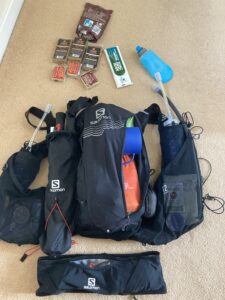28 October, 2022
What you really really need to know if you are preparing for an ultra, is that getting nutrition wrong during an event is cited in up to 40% of ultra marathon DNFs. But how can you avoid this?

The key issues are under feeding, developing Gastro-Intestinal (GI) issues, dehydration, and (occasionally) over-hydrating. In this article we will cover some of the key things you can do to minimise the risks of your gut letting you down on race day.
First some numbers. You need to be able to consume around 250 calories an hour whilst on the move, of which you should be aiming for around 90 grams of Carbohydrate (CHO) with a 2:1 glucose to fructose mix.
These are not absolute numbers, we are all different, but they are a great place to start (and note in most research athletes rarely achieve the 90g/hr of carbs, normally hitting nearer 60).
But nutrition planning and training must be a central part of your overall training plan if you are to be successful.
You must practice eating the food for your event in training. Different foods will have an adverse effect on you and your gut when you start adding exercise into the mix. Whilst a rapid visit to the bush isn’t necessarily an event ending scenario, chronic stomach ache, vomiting and diarrhea can be!
What about fat and protein you cry…yes you need both(!) At around Ultra pace you will be taking about 50% of energy from CHO and the other 50% from fat. Yep, you are an Ultra athlete, so you will be fat adjusted…no fancy diets required.
So how do you develop your nutrition plan? Simply start at expected duration, add 15%, and multiply by 250 (or 90)! e.g. 50 miles, I’m expecting to complete in 8 hours, so I’ll plan for 10. That means I need at least 2500 calories, of which I’ll need 900g of CHO. And you need a mix of foods. Not only the numbers above but you should aim for a protein intake of 0.25g per kg of body weight per hr.
OK, that’s the easy bit. Now what foods will you use. As already stated, although gels are tempting they become sickly at some point for most people. We favour a mix of sweet and savoury, as well as ensuring we have some ‘real’ food thrown in the mix. This can include cold pizza (one of our favourites!), mini pies, sandwiches, fruit and nut trail mix, as well as specialist bars and gels. But note that bars and gels aren’t cheap and they aren’t essential as long as you hit your numbers!
If your event is a series of picnics with a run between (!) ensure you find out what food is available beforehand and train with it. But caution, we have seen many event where the ‘menu’ has changed on the day; I suffered my worst ever ‘bonk’ on a 150 mile cycle ride where this happened and the feed stops only had a brand of gel I knew made me sick…and I foolishly was reliant on them, not myself (lesson learned!).
Ideally, build in your own options. Your palate will change significantly over the duration of an Ultra and you need to have the ability to ‘switch it up’ and keep the nutrition going in.
You should be training with event food twice a week, try overloading your gut and getting even more calories in. And make note of what doesn’t work so you can adapt your plan.
As an example, here’s my (zero aid stations) menu for 50 miles, expected duration around 9 hours (calories in brackets):

How much water you need will depend on the weather, and how much you sweat. But you should be aiming for between 400 and 800 ml an hour.
Under hydrate and you will suffer. So, if you are thirsty, drink. If your pee is orange, drink. If you can’t pee, drink (quite a lot!).
We prefer to stay on top of our hydration by calculating desired consumption (see below) and sipping regularly (every 10 minutes for example).
However, over hydrate and you can be very ill (Hyponatremia) – Damian Hall’s infamous leans at the end of his record breaking UK coast-to-coast could have been much worse. He had overcompensated for the heat, ended up with hyponatremia and could have ended up in a lot of trouble.
The best way of knowing how much water you need to take on is to conduct multiple sweat tests in various temperatures, as follows:

Obviously on a long event in the heat that can be a lot of fluid. There is a balance to be struck between how much fluid you carry and how much you can source either from aid stations, filtering from natural water sources, or from shops. And factor in the forecast and recent weather, expecting to filter water from a stream that’s dried up can quickly become a challenge you don’t need. Equally, under-carrying on a hot day can end your event way too quickly!
Again, we are not nutritionists but…
There’s enough sodium, electrolytes etc in the food you’ll be carrying for the average person; the average slice of pizza has about 500mg of salt. If you think you are an extreme sweater(!) there are companies that will conduct sweat tests on you and provide a bespoke electrolyte plan. Salt tablets aren’t recommended (but we’ve used them) as they can lead to over drinking and subsequently Hyponatremia.
Caffeine can be used in the second half of a 50 (KM or mile) to give you a ‘boost’. 50mg/hr (half a cup of coffee) has been shown to improve performance in the latter half of an Ultra. For longer events, save the caffeine until you are tired. This gives you a double benefit of keeping you more alert and improving performance.
Once you have your nutrition plan, have decided what foods you’ll take and how much water you need to carry…go and practice!
You should have your plans done early and start working with different foods from at least 12 weeks before an event. Aim to have a complete plan with enough time to rehearse it 3 or 4 times pre-event.
| Nutrient | How Much? | When? |
| Total Cals | 240-260 | Every Hour |
| CHO | 60-90g/hr | Every 20-30 minutes |
| Fat | Up to 20-30% of calories | As part of other food |
| Protein | 0.25g/kg/hr | Every 20-30 minutes |
| Water | 400-800 ml/hour. Follow own needs based on plan, and weather. | Every 10-20 minutes |
| Sodium | 3-600mg/hr in hot conditions | As part of other food |
| Caffeine | 50mg/hr | Every hour in second half of event, or when tired for >50 miles |
You may be thinking that running an Ultra can’t be that hard, I mean 50K isn’t that much further than a marathon right? And in some ways the transition from road marathon to Ultra isn’t that hard, if you prepare for the differences properly. In fact the physical running training is a logical, not too extreme, progression from a normal half or full marathon training plan. But an Ultra has a different set of demands, and whilst we believe that with the right training anyone that can finish a half marathon can train to run an Ultra, we know it requires a holistic approach to training; preparing your body, mind and kit.
The UTC approach focuses on ensuring you are fully prepared to deal with all aspects of your Ultra challenge.
Most recent articles by Outside & Active

Brooks supports trail runners to defy limits and empower their trail runs with the new Cascadia 18. The adaptable Cascadia combines DNA Loft v2 cushioning with TrailTack Green grip and a durable upper mesh to handle all terrains, providing necessary comfort and underfoot security on each surface.

Connectivity makes eBiking more customised, convenient and secure.

Various app solutions, interfaces and services as the next step for the eBike experience of tomorrow
Most recent articles in RUNNING

Why is diet such a contentious topic in ultrarunning and why do I call it a myth? These are the topics that I will discuss in this article.

In my last piece for Outside & Active, I talked about what I believed the worst mistake a runner could make is.

Brooks supports trail runners to defy limits and empower their trail runs with the new Cascadia 18. The adaptable Cascadia combines DNA Loft v2 cushioning with TrailTack Green grip and a durable upper mesh to handle all terrains, providing necessary comfort and underfoot security on each surface.